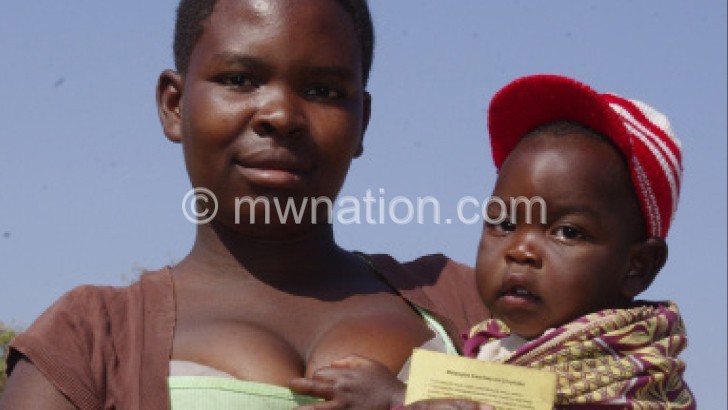Rewriting teen mothers’ tales
At 18, Zione Josophat has a four-year-old baby. The teenager, who quit school in Standard Five at Chisombe in Salima, personifies the plight of half of the girls’ population nationwide.
“I wanted to be a nurse, but my dream collapsed. I dropped out too early. I cannot read or write. All I have is a baby,” she whispers.
She dropped out of school aged 14 in 2013 and married a fisher two years later, a familiar story in her remote setting where societal norms are mostly indifferent to girls’ education.
Nearly half of Malawian women marry before their 18th birthday, a study by the United Nations Population Fund (UNFPA) shows.

of early childbearing
But Zione, who now uses a contraceptive injection to delay and space childbearing, blames it all on early childbearing.
Looking back, she said: “When I became sexually active, it was not easy to find contraceptives. Besides, it’s a taboo for a girl to be seen with a condom.”
Such are the don’ts that adolescents are dissuaded from contraceptives until they have a child—even by chance, not choice.
The teen mother remembers being told she would become barren if she went for the injection.
Multiple challenges to address youth sexual and reproductive health and rights persist.
In the country, teen pregnancies and child marriages cut off young women’s education and limits their chances in life, especially in rural areas where norms and myths impede them to use contraception.
The young women, especially schoolgirls and those who are unmarried, also face a substantial risk of unsafe abortion.
Some want to delay, space or even limit childbearing, but are not using any family method.
The recent Malawi Demographic and Health Survey shows that use of modern contraceptive methods among married women has increased from 42 percent in 2010 to 58 percent.
However, adolescents aged 15-24 have a high unmet need for contraception as 29 in every 100 get pregnant annually—up from 25.6 percent seven years ago.
The youth encounter significant barriers to accessing and using any contraceptives, including lack of family or stable partner, limited knowledge of their contraceptive options, myths and misconceptions, negative social norms and provider bias as to which methods are appropriate for adolescents.
Most of them have no money to get to service sites or to pay for the services, including a condom which safeguards them from unintended pregnancy and sexually transmitted infections, including HIV.
In November 2016, Zione got her first injection to delay childbearing.
“My husband and I agreed to have three children only. Now, we are certain to achieve our dream. We don’t have to have children every year as our peers do. Family planning has given me the room to rest. When we decide to have another baby, my body will be ready for it,” she says.
Child spacing also offers her ample time to do income generating activities, including selling tomatoes, onions and leaf vegetables at Chisombe.
She wishes the contraceptive method, which prevents unintended pregnancy for three months, was handy much earlier.
“No-one knows I am using contraception. But I am reaping the benefits every day,” she says.
In 2015, the global consensus statement on the youth and long-acting reversible contraceptives was adopted by more than 50 influential organisations and governments.
In 2015, UNFPA, which upholds the rights of adolescents and youth to access a range of contraceptive methods, invested about $7.1 million from DfID in the procurement of family planning commodities, midwifery kits and maternal health antibiotics and drugs.
Fortunately, the importance of providing reproductive health information and services to the youth is gaining Capital Hill attention.
Two years ago, government activated the Costed Youth-Friendly Health Services Strategy (2015-2020) which requires health facilities to create safe space for adolescents to access sexual and reproductive health (SRH) services, including family planning, without worrying about onlookers.
Salima District Hospital has a youth-friendly corner where the youth drop in and out daily, but officials say privacy is not guaranteed.
Staff at Mlomba Health Centre in Machinga has set aside Saturday to meet the SRH needs of the school boys and girls.
The workforce—comprising one nurse, one medical and 19 health surveillance assistants—sees almost 30 young clients on the special day.
Says midwife Chifundo Mwehiwa: “When they come, we divide them into two playgroups depending on whether they are married or school-going.
“They play bawo, volleyball and other games while receiving SRH information. Those in need of condoms, contraceptives, treatment for sexually transmitted infections and pregnancy tests go into selected rooms to see skilled attendants for assistance.”
According to Mwehiwa, nearly all the boys prefer condoms while most girls settle for injection.
“They do not want to be noticed by their parents, schoolmates, friends and relatives. They don’t want a backlash. The implants could easily be noticed,” she says.
But Machinga district family planning coordinator Elizabeth Katunga backs efforts to expand contraceptive choice for adolescents and the youth to include long-acting contraception.
“Preventing unintended pregnancies and improving pregnancy spacing among adolescents and the youth will reduce maternal and infant mortality, decrease rates of unsafe abortion and sexually transmitted diseases, keep girls in school and improve their economic opportunities,” she said. n





